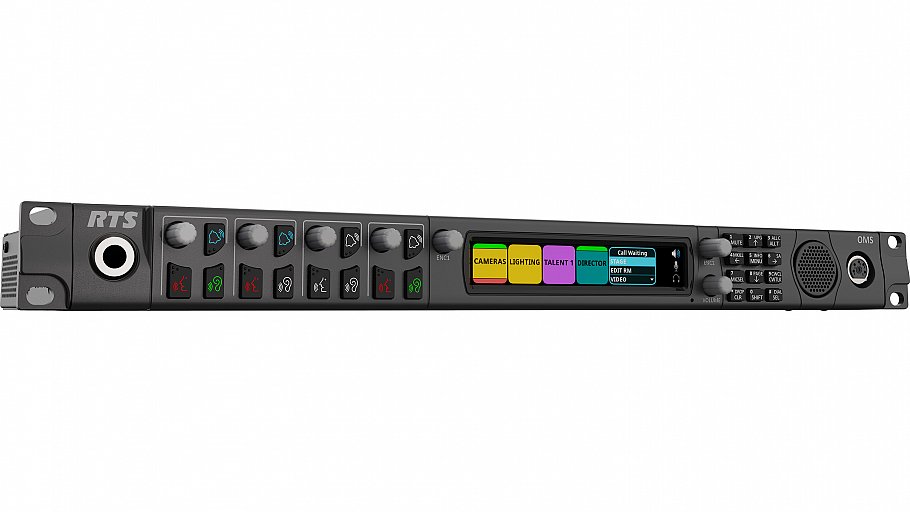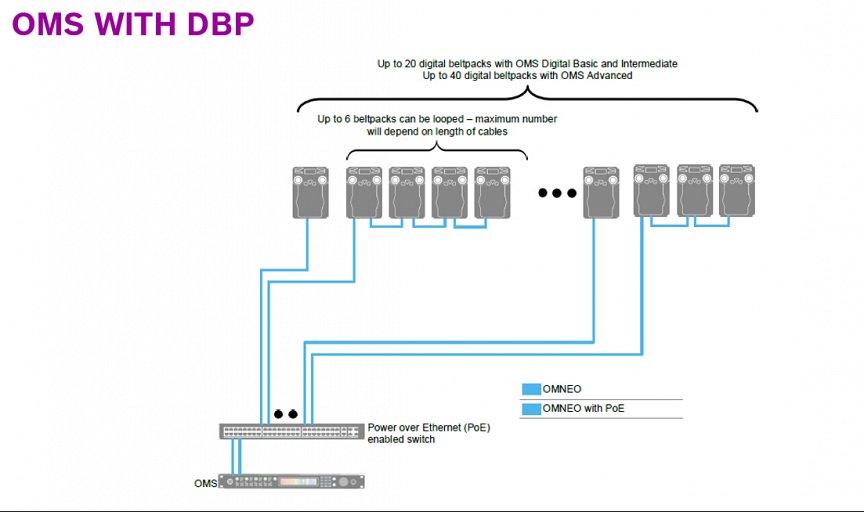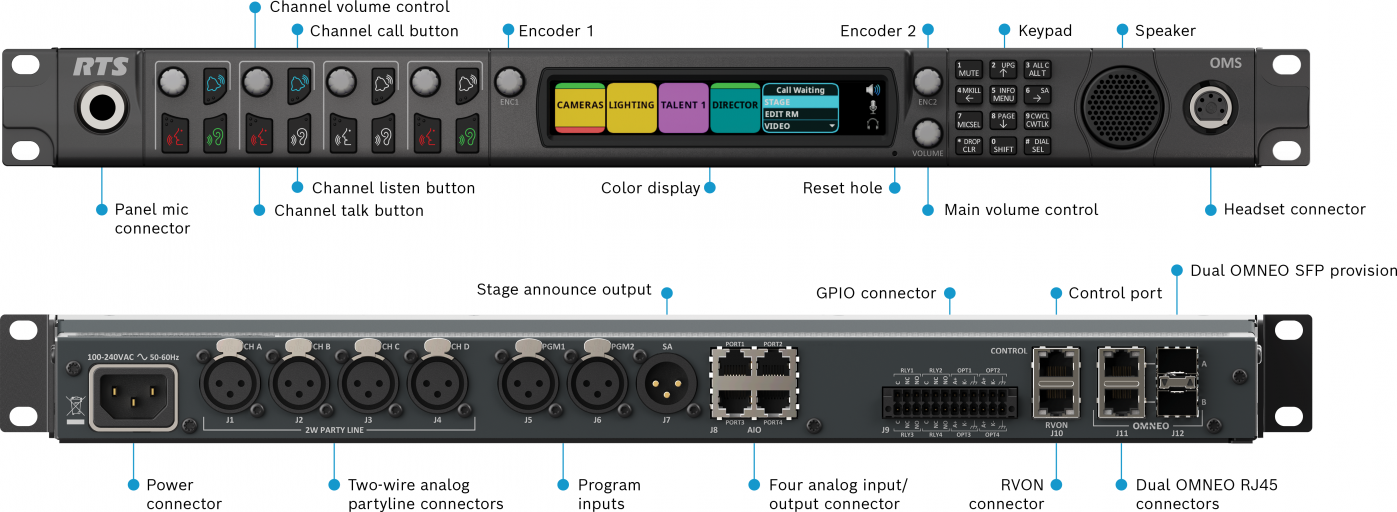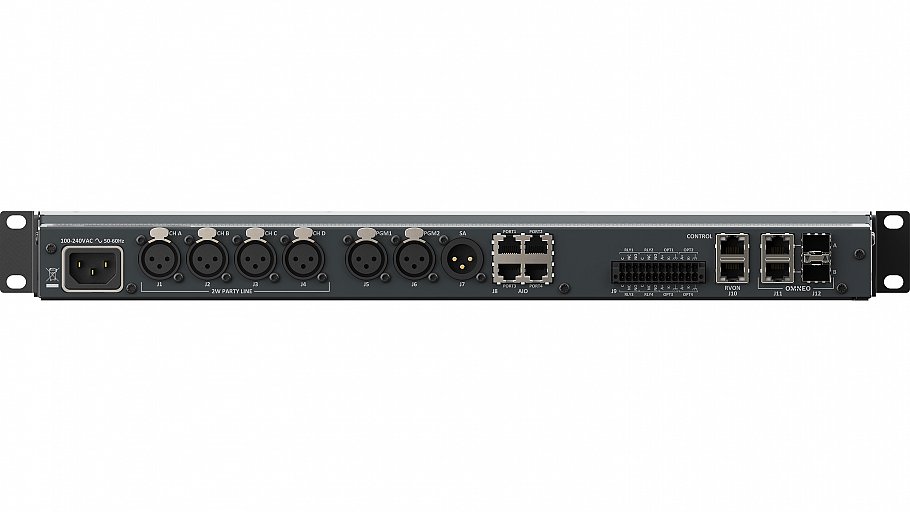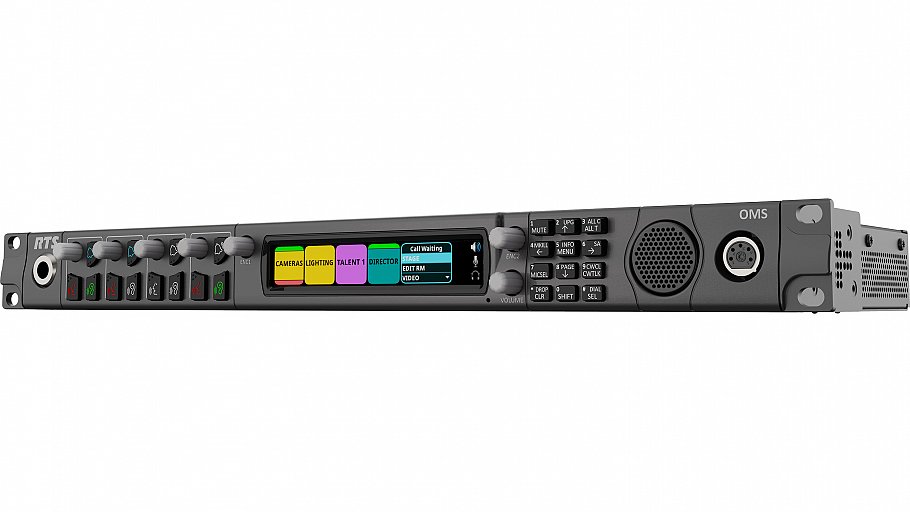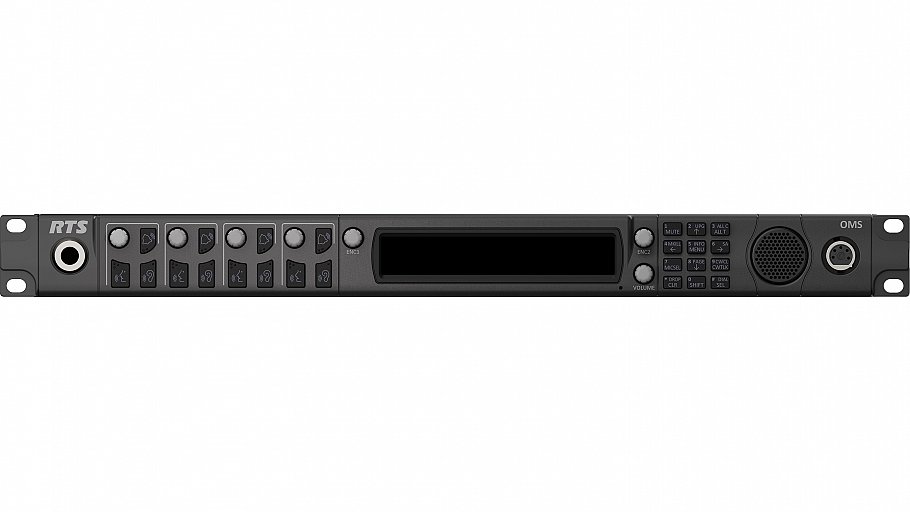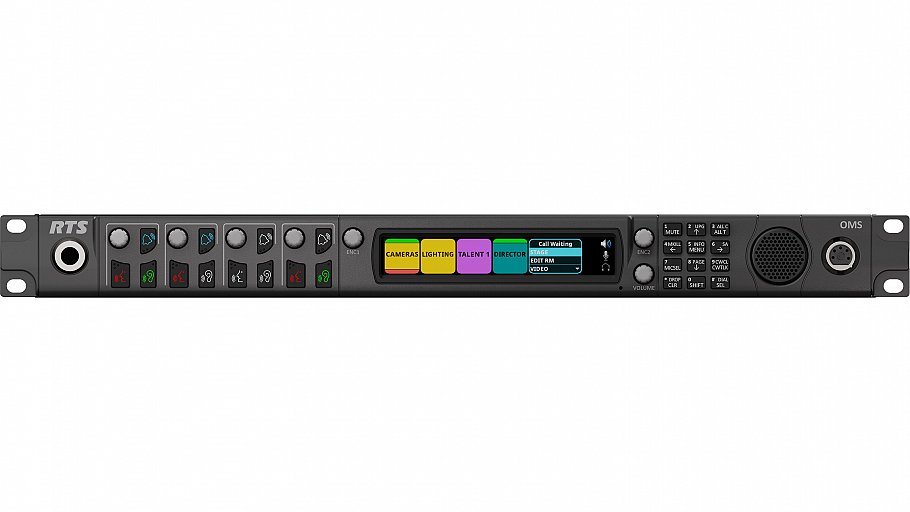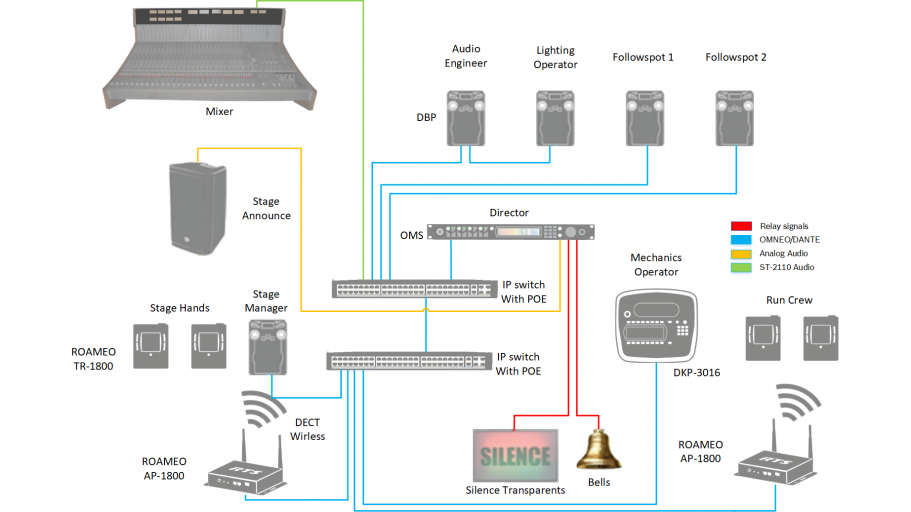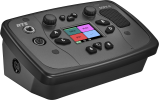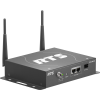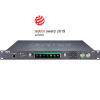OMS
OMNEO Main Station
- Supports up to 40 OMNEO or ROAMEO belt packs and up to 16 party lines. Ethernet connectivity through copper or fiber connections available.
- Supports 4 ports of analog AIO 4-wire and 4 ports of analog 2-Wire (RTS / Audiocom / Clear-Com formats supported). Auto nulling capability (echo cancellation) available on 2-Wire interfaces.
- Supports up to 8 keypanels (any mix of analog/OMNEO/RVON) depending upon product licensing. (Maximum 4 analog)
- Up to 4 RVON channels available with the Advanced license for remote networking with other RVON capable equipment. G.711, G.729ab and G.722 codecs supported.
- Includes stage announce output and additional OMNEO expansion audio ports reserved for connecting and networking with other OMS units. These expansion ports allow additional system capacity and partyline capability as part of a distributed system.
OMS (OMNEO Main Station) is the beginning of a new era of intercom systems called RTS Digital Partyline. This powerful single system bridges legacy analog partyline users who wish to migrate to digital functionality while using their existing equipment. Furthermore, OMS connects both wired and wireless intercom products. OMS represents an incredibly versatile and easy-to-use solution for a wide range of applications – a communications multi-tool for theaters, houses of worship, industrial, broadcast and event venues.
Using OMNEO, OMS interconnects with our digital matrix products including keypanels, ROAMEO wireless and digital beltpacks. OMNEO is an architectural approach to connecting devices that need to exchange information such as audio content or device control (Dante & control). In addition, it can serve as a stand-alone base station for ROAMEO, RTS’s digital wireless communication solution based upon DECT.
The OMS is available in five licensed models; Analog Only, Analog Plus, Basic, Intermediate and Advanced. The OMS allows for increased capacity and functionality as business needs grow.
The OMS has the easy-to-use RTS digital icon-based front panel display, along with a simplified menu structure to allow system configuration and control from the front panel and display.
OMNEO MAIN STATION - FEATURE TABLE
| Analog | Digital | ||||
|---|---|---|---|---|---|
| Feature | OMS Analog | OMS Analog+ | OMS Basic | OMS Intermediate | OMS Advanced |
| Analog two-wire ports (RTS/ Audiocom/CC) |
4 | 4 | 0 | 4 | 4 |
| 2W loop tdru | Yes | Yes | N/A | Yes | Yes |
| Program inputs | 2 | 2 | 2 | 2 | 2 |
| Stage announce | 1 | 1 | 1 | 1 | 1 |
| GPI / relay | 4 GPI / 4 Relays | 4 GPI / 4 Relays | 4 GPI / 4 Relays | 4 GPI / 4 Relays | 4 GPI / 4 Relays |
| 2W auto-nulling | Yes | Yes | N/A | Yes | Yes |
| # of conferences | 4 | 16 | 16 | 16 | 16 |
| 2W Mixing / routing | No | Yes | No | Yes | Yes |
| Four-wire AIO ports | No | 4 ports | No | 4 ports | 4 ports |
| Audio expansion (tie lines) | No | 8 ports | 8 ports | 8 ports | 8 ports |
| Built-in line powering | No | No | No | No | No |
| Max OMNEO device connections | 0 | 0 | 20 | 20 | 40 |
| Digital beltpacks supported | 0 | 0 | 20 | 20 | 40 |
| ROAMEO beltpack supported | 0 | 0 | 0 | 20 | 40 |
| RVON ports | 0 | 0 | 0 | 0 | 4 |
| KP capacity | 0 | 4 (analog only) | 4 | 4 | 8 |
| Fiber support | No | No | No | Yes | Yes |
Specifications
| Power Supply | ||||
| Type | Locking IEC 320 C14 style connector | |||
| AC Input | 100 VAC – 240 VAC, 60/50 Hz, 0.46 A / 0.24 A | |||
| Maximum Power Consumption | 30 W (based on 120 VAC) | |||
Specifications |
||||
| Environmental | |
| Operating Temperature | 32° F – 113° F (0° C – 45° C) |
| Storage Temperature | -4° F – 158° F (-20° C – 70° C) |
| Dimensions | |
| 19" w/ rack ears (17.56" w/o rack ears) W x 1.7" H x 7.72" D (including connectors) | |
| (482.6 mm w/ rack ears [446.1 mm w/o rack ears] W x 43.7 mm H x 196.1 mm D [including connectors]) | |
| Weight | |
| OMS chassis | 5.29 lbs (2.4 kg) |
| AIO 4-Wire Analog | |
| Connectors | 4 RJ-45 connectors |
| Signal Format | Differential RX/TX audio with differential RS-485 control data |
| Wiring Scheme | Both 568B & USOC supported |
| A/D and D/A Resolution | 24 bits |
| Max Input Level (balanced) | +20 dBu w/o clipping |
| Digital Input Gain | Programmable (-20 dB – +20 dB) |
| Input Frequency Response | +1 dB/-3 dB from 100 Hz – +20 kHz |
| THD+N (8dBu input, unity gain) | 0.025% non-weighted@1 kHz <0.075% non-weighted, 100 Hz – +20 kHz |
| Nominal Input Impedance | >22 kΩ |
| Nominal Output Level | 8 dBu |
| Digital Output Gain | Programmable (-20 dB – +20 dB) |
| Maximum Output Level (balanced) | 20 dBu w/o clipping |
| Output Frequency Response | +1 dB / -3 dB from 100 Hz – +20 kHz |
| Output Noise Floor | <-65 dBu |
| Crosstalk Isolation | >80 dB |
| PGM1 & PGM2 | 3-pin XLR-F |
| Signal Format | Differential RX/TX audio |
| A/D Resolution | 24 bits |
| Max Input Level (balanced) | +20 dBu w/o clipping |
| Digital Input Gain | Programmable (-20 dB – +20 dB) |
| Input Frequency Response | +1 dB/-3 dB from 100 Hz – +20 kHz |
| THD+N (8dBu input, unity gain) | 0.025% non-weighted@1 kHz <0.075% non-weighted, 100 Hz – +20 kHz |
| Nominal Input Impedance | >22 kΩ |
| Nominal Output Level | 8 dBu |
| Digital Output Gain | Programmable (-20 dB – +20 dB) |
| SA (Stage Announce) | 3-pin XLR-M |
| Signal Format | Differential RX/TX audio |
| D/A Resolution | 24 bits |
| Max Input Level (balanced) | +20 dBu w/o clipping |
| Digital Input Gain | Programmable (-20 dB – +20 dB) |
| Maximum Output Level (balanced) | 20 dBu w/o clipping |
| Output Frequency Response | +1 dB / -3 dB from 100 Hz – +20 kHz |
| Output Noise Floor | <-65 dBu |
| Crosstalk Isolation | >80 dB |
| 2-Wire Party Line Analog | |
| Connector | four 3-pin female XLR connectors |
| Modes/Port supported | RTS CH1, RTS CH2 Audiocom (4 channel) Clear-Com (4 channel) |
| 4W/2W Echo Return Loss | >45 dB |
| Unbalanced Operation (RTS/Clear-Com) | |
| Expected Termination Impedance | 200 Ω |
| Noise Contribution | <-70 dBu |
| THD+N (w/ nominal input) | <0.5%, 200 Hz – 7.3 kHz |
| Bridging Impedance | >10 kΩ |
| CALL Signaling | 20 kHz (RTS mode) 12 VDC (Clear-Com mode) |
| MIC KILL Signaling | 24 kHz (RTS mode) |
| Balanced Operation (Audiocom) | |
| Expected Termination Impedance | 300 Ω |
| Noise Contribution | <-70 dBu |
| THD+N (with nominal input) | <0.5%, 200 Hz – 7.3 kHz |
| Bridging Impedance | >10 kΩ |
| CALL Signaling | 20 kHz (Audiocom mode) |
| MIC KILL Signaling | 24 kHz (Audiocom mode) |
| General Purpose Input/Output Ports | |
| Relays (4 Relays) | |
| Type | SPDT |
| Contacts | Common (C) Normally Closed (NC) Normally Open (NO) |
| Contact Rating | 1A @ 30 VDC |
| Inputs (4 Inputs) | |
| Type | Optically Coupled |
| Input Voltage | 5 VDC – 12 VDC on A+ |
| Note | A+ is internally pulled to +5 VDC. Connect Kto chassis ground to activate. |
| Control Port | |
| Connector | RJ-45 |
| Format | IEEE 802.3 compliant |
| Speed | 10/100/1000 Mbps |
| LEDs | Speed and Link/Activity |
| OMNEO Port (primary and secondary) | |
| Maximum Capacity | 48 Full-duplex ports |
| Copper Connector Type | RJ-45 |
| Format | IEEE 802.3 compliant |
| Copper Ethernet Speed | 100/1000 Mbps |
| LEDs | Speed and Link/Activity |
| Fiber Connector Type | Small Form Factor Pluggable (SFP) |
| Multimode | Finisar FTLF8519P3BNL 500m / 2.125Gbps |
| Single Mode | Finisar FTLF1421P1BTL 15km / 2.67Gbps |
| Fiber Speed | 100/1000Mbps |
| LEDs | Speed and Link/Activity |
| LED Indicator | Optical Signal Present |
| Note | SFF-8472 fiber diagnostics supported |
| RVON | |
Videos
RTS digital partyline intercom: Meet OMS & DBP
RTS Digital Beltpack (DBP) for OMNEO Main Station (OMS) Webinar
RTS Digital Partyline OMS - OMNEO Main Station
OMS (OMNEO Main Station)
DBP Digital Partyline Intercom Beltpack Overview by Nico Lewis
OMS OMNEO Intercom Main Station Overview
OMNEO Media Network Technology for RTS Intercom Systems
DBP Overview by Angelo Piga
OMS OMNEO Main Station at #infocomm
Downloads
Warranty & After Sales Programs
